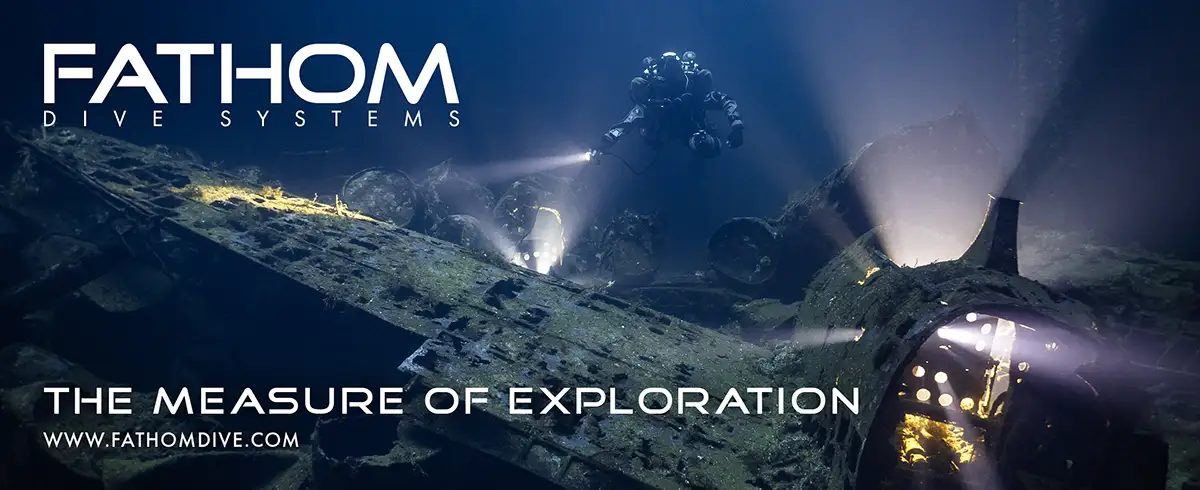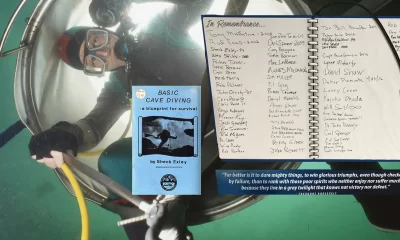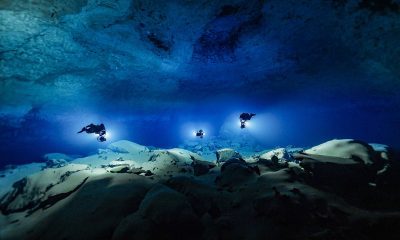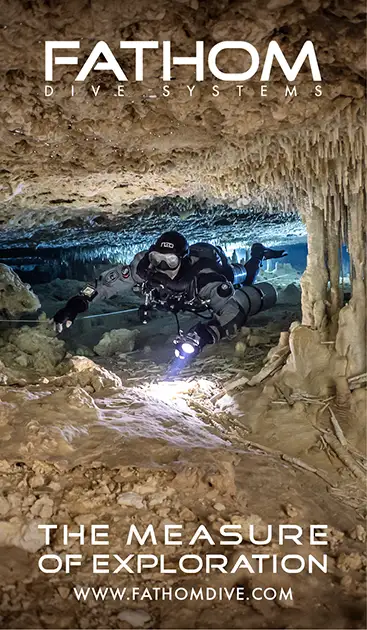Cave
Shedding Light On Darkness: Our Plunge Into GUE’s Cave 1 Course
Remember the first time you stuck your head in an underwater cave? Recreational diving instructor Justin Barbour sure does. After his first cavern foray at Ginnie Springs last fall, he swallowed his trepidation, and he and his GUE dive buddies signed up for a Cave 1 course in Mexico. In addition to learning to manage an escalating series of valve, manifold, regulator, and light failures, here’s what went down.
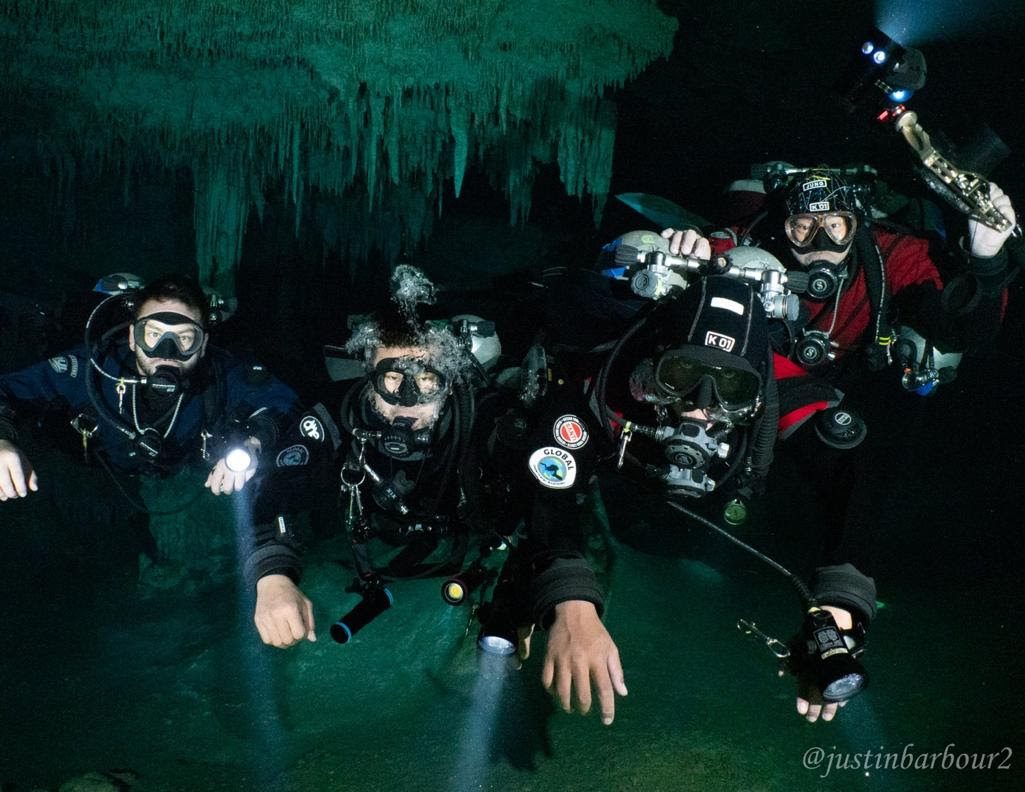
by Justin Barbour
Header photo by Justin Barbour
There is always one style of diving that most divers are quick to avoid: Cave Diving. It has developed a reputation as being one of the most dangerous styles of diving in the world, and the divers who do it regularly tend to be categorized as insane. This was definitely my thoughts when I initially signed up for my cave diving class. I was constantly told that cave divers were tempting mother nature to flick them into the afterlife at high speed.
So why sign up for a class that you’re scared of? I was looking for a new challenge. After one of my teammates returned from Mexico from his first cave class it was all he could talk about. I joined him in Florida at the GUE Conference last year and decided to test the waters out in Ginnie Springs at The Ballroom. The moment I passed through the opening and saw the whole room open up I was hooked. The feeling of being able to overcome the fear of the unknown was something I truly never thought I would be able to do and it was incredible. Swimming around the room and looking at the rock work, exploring the cracks and crevasses, experiencing a new kind of darkness, it can easily be seen how addicting this could be. The next day my teammate Fred Espino and I signed up for our Cave 1 class in Mexico.
We trained for months diving as often as we could both during the day and night to simulate the feeling of being in a cave. Running line around rocks, a seemingly endless number of valve drills and s-drills, and fine tuning our positioning kicks to make sure we were ready to hit the ground running when we arrived. After every dive I caught myself thinking “are we really about to fly to Mexico and hop into a cave?” I asked myself that question even right up to the point of throwing my carbon fiber backplate into my pelican case the day before my flight.
Once in Cancun, it’s about an hour-long drive to Zero Gravity (ZG). At times the roads can feel a bit like Mario Kart brought to life, but it only added to the sense of adventure we were embarking on. Once we arrived at Zero Gravity, we were immediately introduced to Christopher Le Maillot and Fred Devos, the two owners of Zero Gravity. Between the two of them they have an uncanny ability to make you feel immediately at home.
There are early mornings at ZG. Before the sun rose on our first day we were up and working on our gear. We had dives planned that day to get acclimated to diving in this new environment and some last-minute rehearsals on skills. We arrived at the Dream Gate cenote and were in awe. We briefed and got our gear together with our guide as fast as possible and climbed down the ladders to get inside of the cave. Once in the water, trying to take in this wild moment in our lives, I realized that any notions of fear that I had were completely gone. It was only the giddy feeling you feel as a kid coming down the stairs on Christmas morning.
As we descended into the cavern, we quickly realized how people can get hurt. Caves are the darkest places on Earth, and yet inspire a sense of wonder. As our can lights cut through the darkness, they begin to reveal the true beauty of the cave. The speleothems, or decorations, are some of the most magnificent parts inside of the caves in Mexico. These stalactites and stalagmites are remnants from when the cave was dry before the last ice age. As we swam through the cave, we realized that we are truly swimming through a frozen moment in time. Looking at the walls you can see the different types of rock layers as they were built up over tens of thousands of years.
The next morning, we got to meet our instructor Laszlo Cseh. We spent most of the first day in the classroom going over theory, the history of cave diving, and the basics for why the rules are set in stone. Laszlo seemed to have an endless supply of examples for these rules in real life scenarios which seemed to be calming rather than alarming to us. That afternoon we drove to our first cenote Xtabay where we got to run through safety drills and such to make sure our fundamentals were down before running our first line into the cave. After a few practice runs in the open water portion it was time to try our first line run into the cave.
The cave initially opened up into a massive room with an enormous triangular rock in the middle of it from the last time the roof collapsed. Once we got to the top of the rock, we were able to tie into the main line and do our initial checks of gas, time, and a quick flow check. Laszlo however had other plans for us. Running up and down the line practicing our kicks to make sure they were perfected for our first official cave dive the following morning. Even that little rush of running the line from open water to the main line was amazing.
The following morning, as with every morning, we were up and downstairs bright and early analyzing our tanks and making sure our gear was good to go so we could get to the cenote first. Upon arrival we quickly set our gear up, listened to the briefing by Laszlo, and walked back into Xtabay for our first official cave dive. Fred ran the line in this time and made quick work up to the main line. From there we were able to proceed into the cave.
One of the first things we realized when in the cave is the vastness of it. Shining our lights ahead we couldn’t see where the end of the beam was, even with crystal clear water. Once we left the entrance, we immediately came to what is known as a Halocline. This is where the saltwater in the bottom of the cave meets with the freshwater creating a false ceiling. As you pass over it, it looks like you’re swimming over a pool inside of the cave. This is something that can play tricks on the mind particularly to a disorientated diver on heading out of the cave.
As we swam through it the fresh and saltwater began to mix clouding the visibility to near zero. Once we staggered on either side of the line however we were able to maintain visual contact with each other, the line, and were able to enjoy the 86ºF/30ºC saltwater that we just dipped into.
The colors in the cave were incredible. The blues and greens were striking as our lights slowly moved about the cave. The rock walls were white in the saltwater, and a tan color in the freshwater.
As we moved room to room, I glanced at my computer and realized we’d been swimming for 30 minutes. While that’s not an unusual time for an open water dive, I rapidly came to the realization of “wait, if something goes wrong, we’re going to have to turn around and swim at least another 30 minutes to get back out.” It was this sobering thought that helped me understand the severity of what we were doing. Nothing a few glances around the cave couldn’t snap me out of the thought and continue on with the dive.
As we continued to swim, we came upon a bed plane section of the cave. This is where the cave narrows, but not too small, vertically and can stretch for hundreds of feet horizontally. As we swam forward, we truly started to feel like cave divers. Alas only a few minutes into the dive we hit our turn pressure and had to exit the cave.
As we surfaced Fred and I immediately popped our regulators out of our mouths and exploded with excitement. It seemed like months of hard work and uncertainty finally paid off in that moment, and it was only day two of the class. Laszlo, in his usual Laszlo calm and collected nature, reigned us in with a subtle, “Meh it was ok, let’s see how you do in the cave.” Little did we know the gauntlet that was ahead of us.
Throughout the class we would arrive first thing in the morning, set up our gear, run through dry drills, gear up, and do three to four dives in a day. Upon finishing those we would drive back to ZG and would be in theory for a few more hours before finally being sprung loose for tacos at Marre Marre across the street. They were very long days to say the least, yet every morning we would wake up before our alarms and couldn’t wait to see what the next set of dives had in store for us.
The next few days were filled with every failure that Laszlo and his trusty bubble gun sidekick could think of. From light failures (primary and both back up lights), to regulator failures, we drilled until it became second nature. On one particular dive we were particularly tested. As we swam through the cave just as we were passing through a thermocline I had a simulated primary light failure. After going through the procedures for stowing, deploying backups, etc. Fred and I turned the dive and started our exit. Suddenly he also experienced a simulated primary light failure and had to go through that process. One thing after another happened honing in our focus to the point where we found ourselves in total darkness. As we stayed in touch-contact we moved along the line as a unit. This shows a level of trust in not only your training, but your teammate as well.
Though as the days went on our confidence began to grow swimming around in the caves. Our awareness began to expand to allow us not only to focus on the team, but also begin to actually see the cave. Looking for the jump lines off the main line, seeing more of the details in the room, genuinely being able to take in the vastness and natural beauty that helped shape these caves over millennia.
On the final day we were tasked with two of the most important skills a new cave diver can learn: lost line drill while blindfolded, and gas share exit while blind. These are skills that hopefully a diver never needs to use, however we are going into a hostile world every time we enter a cave, so it’s important to train for every scenario to be prepared for whatever is thrown our way. In a strange way having the blindfold on elicited a sense of calm like I’d never felt. One hand on the line, the other out in front feeling our way out, with Fred hanging onto my elbow, we moved as a unit through the cave, navigating each station (tie off on a rock) as we moved. It felt like a new puzzle each time we came to a station as we moved our way out.
By the end of the day, Laszlo decided that we’d been through enough and we officially were Cave 1 divers. The feeling was hard to describe for a number of reasons. Chiefly both Fred and I had finally reached the moment we had been training for, studying for, and fearful about. We passed. We were officially apart of that group of divers most people think have a screw loose.
Looking back on what we learned and experienced, it’s clear to see that there are really only a few hard-fast rules to follow, similarly and readily transferable to open water dives, which minimize the risk we take on in the caves. First, plan your dive and dive your plan. This includes careful gas planning, and everyone taking responsibility for their own gear, gas, and navigation. Having a continuous guideline starting in open water, so that even in zero visibility you can always find your way out. Maintain your equipment making sure all regulators, valves, and lights are in prime shape to avoid potential problems in the caves. And lastly, ALWAYS be aware of the mainline. With these in mind one can go around the world swimming through the history books in caves and mines exploring what once was and embracing the beauty of what is.
Dive Deeper:
GUE Cave 1 Description
Cave 1 Video

Diving since 1998 from the Maldives to the Midwest, Justin is a PADI Master Scuba Diver Trainer and GUE Diver who brings a courageous mentality and humorous demeanor to the water. From 2015-2020 he spent countless hours volunteering at the Aquarium of the Pacific applying his expertise to educate children on sustainable ocean interaction.
As a boy he would read constantly about marine biology, wanting to see it for himself he dove right in and has hardly been up for air since. Most intriguing to him is exploring and learning the history of shipwrecks. Justin’s life above sea level includes a career path that has taken him from medical sales to tech startups, every endeavor inspired by the tenacity of being a former collegiate athlete. His goal is to never stop pushing himself, allowing the water to continually reveal character and to share those experiences with others.













